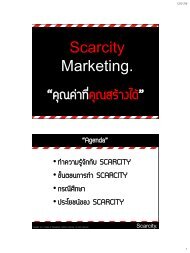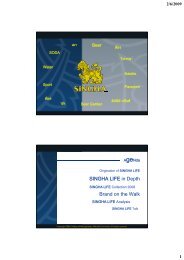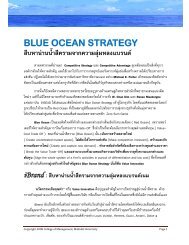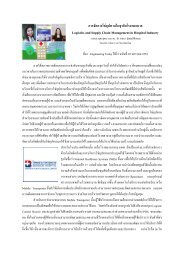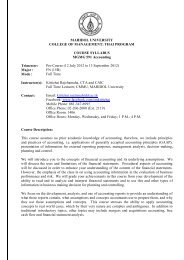Credit Card Market Nov 2002.pdf
Credit Card Market Nov 2002.pdf
Credit Card Market Nov 2002.pdf
- No tags were found...
You also want an ePaper? Increase the reach of your titles
YUMPU automatically turns print PDFs into web optimized ePapers that Google loves.
The Emerging <strong>Credit</strong> <strong>Card</strong> <strong>Market</strong> in Thailand: An Exploratory Study Investigating<strong>Credit</strong> <strong>Card</strong> Repertoires and Choice Criteria in ThailandRandall Shannon, Assistant ProfessorFaculty of Business AdministrationThe University of the Thai Chamber of Commerce126/1 Vibhavadee Rangsit Road, Dindaeng – Bangkok 10400 Thailand662 692 3050 extension 2112 (office)662 276 2126 (fax)arash@mail.utcc.ac.thChanin YoopetchFaculty of Business AdministrationThe University of the Thai Chamber of Commerce126/1 Vibhavadee Rangsit Road, Dindaeng – Bangkok 10400 Thailand662 692 3050 extension 2112 (office)662 276 2126 (fax)achyo@mail.utcc.ac.th(Presented and published at the Association of Private Higher Education Institutes of Thailandconference in Bangkok, <strong>Nov</strong>ember 2002).1
The Emerging <strong>Credit</strong> <strong>Card</strong> <strong>Market</strong> in Thailand: An Exploratory Study Investigating<strong>Credit</strong> <strong>Card</strong> Repertoires and Choice Criteria in ThailandAbstractThe penetration of credit cards has been low in Thailand for decades, possibly due to highincome requirements above the reach of the mass market. The economic recession that hit in1997 slowed an economy which had seen nearly ten percent growth for a decade. In anattempt to help stimulate the economy and also allow banks to compete with non-financialinstitutions, the requirements set by the Bank of Thailand for credit card applications wererecently waived. As a result, the credit card market is expected to nearly double by the end of2002. As the market is becoming increasingly competitive with foreign companies enteringthe market, companies are offering various types of promotions, but are they attractive toconsumers? Ethical issues may arise as consumers may face high interest rates – many ofwhich lack transparency. Exploratory survey research was conducted to learn more about theownership of credit cards, as well as the importance of various criteria when selecting a creditcard. Findings are discussed, as well as directions for future research.Introduction<strong>Credit</strong> cards have been available in Thailand since the launch of Diner’s <strong>Card</strong> in 1969.Despite being in the market for thirty-three years, the penetration and usage of credit cardshas remained low. The growth of credit cards stalled after seeing promising growth in theearly nineties. Companies have become more aggressive at marketing cards, and anincreasing number of foreign competitors are entering the market. The number of credit cardsissued in Thailand grew by 13% in 2000 and 44% in 2001 for a total of 2.6 million cardsissued among a population of 62 million – less than 5% penetration. Table 1 illustrates thenumber of cards issued over the past five years, which is when the country was hit byeconomic recession. 143,000 cards were issued in 1986, increasing to nearly 1.4 millioncards by 1993 and 1.9 million in 1995 (TFB Research, 1996).Table 1: <strong>Credit</strong> <strong>Card</strong>s Issued in Thailand by Commercial Banks1997 1998 1999 2000 2001# <strong>Card</strong>s (millions) 2.0 1.9 1.6 1.8 2.6% change -5 -16 +13 +44<strong>Card</strong> usage (billion baht) 149 147 152 170 224% change -1.3 +3.3 +12 +32Outstanding credit 45.5 43.4 33.6 32.6 41(billion baht)% change -5 -23 -3 +26<strong>Credit</strong> card as percent oftotal loans (%).98 .97 .73 .77 1.022
Source: Bank of ThailandPreviously, the Bank of Thailand (BOT) regulated the age and income requirements for allbanks issuing credit cards. These restrictions were relaxed twice during the first half of 2002,and then waived altogether in April, leaving banks to set their own requirements for creditcard applications. There has been increasing competition from non-financial institutionsoffering cards, which are not regulated by the BOT. While the two groups claim to targetdifferent segments, it appears they will all be focusing on the mass market, which is lowincome(the average monthly income in Bangkok is 7,700 and about half that outside of thecapital. This seems to offer a potential conflict, as previous work has found that credit cardstend to be marketed towards those with higher education and income (Mandell 1972), and thathigh income is the most important determinant for increasing the number of credit cards(Kinsey 1981). The non-financial institutions offering credit cards, such as Aeon and GECapital, have been posting double-digit growth by offering cards to the low-income segment.Requirements for obtaining a card from a non-financial institution have been up to one-fourththe income required for a bank-issued card, e.g. 5,000 baht compared to 20,000 baht. Withthe requirements now waived and increased competition, the number of credit cards issued isexpected to grow rapidly. Facing heavy competition, the question arises as to how best tocapture the interest of consumers. It was proposed that exploratory research be conducted todetermine what types of cards consumers have, and also explore the criteria used whenchoosing a credit card.MethodologyA self-completion survey was administered using convenience sampling, wherein studentshelped distribute and collect the questionnaires in offices throughout various areas inBangkok. 200 questionnaires were distributed, of which 138 usable surveys were returned.Most questions used 5 point Likert scales and explored consumer level of knowledge andbehavior as relates to banking and credit cards. Questions about credit cards capturedownership of specific types of cards (regular, gold, platinum), whether it was their own cardor a supplement, and criteria for choosing cards and the weight of importance. The itemsused for criteria were a reduced set based on those used by Meidan and Davos (1994). SPSS(version 11) was used to tabulate and analyze the data. After the survey was completed andanalyzed, qualitative research was conducted among other credit card users via in-depthinterviews to explore additional issues such as card repertoires, face and status.FindingsOut of 138 returned questionnaires, 82 respondents (59%) had credit cards. The age andgender breaks of the sample closely match that of the population, although the incidence ofowning a credit card was much higher than average – perhaps due to being distributed amongoffice workers. As seen in Table 2, Visa was the most frequently reported type of cardowned. That is not surprising, considering that out of 2.6 million cards issued, the Bank ofThailand shows that 1.9 million are Visa cards, giving them approximately 70% of the marketshare. It is interesting to note that Citibank Visa has such a high share, despite that fact thatthey charge higher interest rates than most other bank issued cards. In fact, the interest ratescould not be found posted on their website or the card application form, making it difficult forconsumers to make an informed decision – aside from being a well known brand/bank.3
Table 2: Ownership of <strong>Credit</strong> <strong>Card</strong>s by BankNamePercentCitibank Visa 41%American Express 38%Bangkok Bank Visa 21%Thai Farmer’s Bank Visa 16%Standard & Chartered Visa 15%Diner’s Club 15%Krung Thai Bank Visa 11%Siam Commercial Bank Visa 10%Base: All Respondents Owning <strong>Credit</strong> <strong>Card</strong>s (n=82)In exploring potential differences between those owning cards and those not, age and incomewere the only variables showing significance. Using ANOVA, differences were found inregards to income - those with higher income were more likely to own a credit card than thosewith lower income (the F statistic was 27.3 (p
American Insurance Association. Due to the fact that the companies are not regulated, andpresumably because they are taking a higher risk, the interest rates are typically higher forcredit cards issued by non-financial institutions than from banks. Interest rates are notconsistent across cards, even among those issued by banks. It would seem likely thatconsumers face choice confusion when trying to choose a card. Consumerism is not strong inThailand and few criticisms have been voiced about the interest rates charged. In preparingthis, the authors found that many companies (including banks) did not even provideinformation about interest rates charged, and when such information was provided, it lackedtransparency. Consider this point excerpted from the Central card contract:“The interest and the <strong>Credit</strong> Usage Fee shall accumulate on a daily basis until the balance isfully paid. The interest shall be charged at 12% per annum. The <strong>Credit</strong> Usage Fee shall becharged at 24% per annum. The interest plus the <strong>Credit</strong> Usage Fee is called the <strong>Credit</strong> UsageCharge.”Despite many arduous years of higher education, neither of the authors could clearly explainwhat the above means. A telephone call revealed that 4% of the balance (minimum of 400baht) must be paid each month and that the additional fee is based on the amount charged.For example, if a consumer made a 10,000 baht purchase, it is interest free if paid within 50days. Fees are applied to late payments, but if the balance is deliberately carried over 50days, the minimum payment would be 400 baht, thus carrying a balance of 9,600. Interestwill be charged at 1% on the balance monthly (12% annually). Additionally, 2% of theoriginal purchase amount (10,000 baht) will be charged each month that the balance is carried(24% annually).When carrying a balance longer than one month, banks typically offer interest rates from 16-27%, although there can be hidden fees as well. For example, some companies charge a 5%fee if the balance is paid off earlier than two years. Several non-bank cards offer an interestcharge of 5% of the balance carried per month, which would equate to 60% interest per year.Quoting figures on daily, monthly or annual basis can seem a bit like deceptive marketing,much like showing the daily or weekly price of financing a product rather than the total fee.Table 4 shows a list of offerings of cards from five banks and three non-financial institutions.This illustrates the potential confusion that consumers face, especially if they are not familiarwith how credit cards and interest charges work.5
Table 4: Selected <strong>Credit</strong> <strong>Card</strong>s Issued in Thailand by Commercial BanksContrasted with <strong>Card</strong>s from Non-Financial InstitutionsName of Company Joining Fee Annual Fee Interest RateBank of Asia 800 baht 600 regular MRR(7.75%) +8.25% = 16%1200 goldBangkok Bank 500 baht silver 600 silver MRR(7.25%) +9.75% = 17%1,000 baht gold 1,100 goldCitibank500 silver750 gold750 silver1,250 goldFirst 3 months 0%afterwards 23%Thai Military Bank 500 baht 600 regular MRR(7.75%) + 10% = 17.75%1000 goldUOB Rattanasin Bank 500 baht 600 regular MRR(8.5%)+8.5% = 17%1200 goldAeon Mastercard None 200 baht 2.4% per month = 28.8%Central 100 baht 100 baht 12% per year + credit usagecharge of 2% per monthTesco None 100 baht 12% per year + credit usagecharge of 2% per monthSources: Company Sources and Press Releases.All of the companies listed in Table 4 have websites and most offer online or fax applications,yet very few list the interest rates or other fees. If consumers are to make any type of logicaldecision or compare options, this would be the main information required – yet it is notoffered.An alternative view to this ‘abuse’ is that it may be a matter of perspective in terms of whatlevel of interest is considered fair, as previously the most widely available option would be toborrow from outside the system, essentially meaning private loan sharks who might charge upto 300% interest. Firms are offering more choice, although not in a transparent manner.Encouraging Use, Building up Debt?With the aggressive steps taken to spur credit card use, the numbers of cards issued haveclearly been increasing, although spending to a lesser degree. It is possible that someconsumers may be carrying more than one card, and banks may induce people to join to findthat they cancel their card as soon as the promotion period is over (often one year with noannual fee, possibly with some gifts for joining). The Bank of Thailand has warned banks tobe careful regarding their debt repayment and to set aside adequate loan-loss reserves, as theyare basically offering a loan service without collateral. The National Economic and SocialDevelopment Board warned that recent deregulation and higher competition could lead toasset quality concerns for banks (Srisukkasem 2002a). Aeon has stated that their nonperformingloans are approximately 2% annually. Some posit that their success stems fromtheir relationships with customers, in that they immediately contact an overdue customer andoffer to renegotiate the terms of payment.Some economists say that increased availability of consumer credit may increase sales anddemand figures in the short term, but could lead to problems in the future. It is interesting tonote that the recent changes have already been questioned, and that discussions are currently6
underway to set forth new income requirements, as well as imposed ceilings for interest rates(Srisukkasem 2002b).<strong>Card</strong> RepertoiresLunt (1992) found that no particular brand of card has been able to gain loyal users over othercards, which might make one question the marketing effectiveness of any particular brand orperhaps question the concept of single brand loyalty. The existence of brand repertoiresreveals that measuring proportional loyalty may be a more prudent choice, as few people areloyal to a single brand and that brand usage tends to mirror market share (see Ehrenberg et al.1990 or Ehrenberg and Uncles, 1999 for more). Considering the lack of segmentation foundin a study across multiple countries and industries, including owners of credit cards (Kennedyand Ehrenberg 2000), the logic of brand repertoires is difficult to refute.Our survey captured the number of types and brands of cards held by those owning creditcards. As can be seen in Table 5, the majority of cardholders own more than a single card(five being the most reported, while most respondents had two or three cards from differentbanks). Usage was not explored in this research, but unless obtained during a promotionalperiod, cards have annual fees, thus owning multiple cards would subject the cardholder toextra expense – for what benefit? If credit cards charge an annual fee, should they beclassified as a subscription market? In-depth interviews revealed that some holders ofmultiple cards were actually rotating their debt across cards, a dangerous practice that canlead to ballooning interest fees. It was also found that many consumers hold a credit cardfrom a bank, yet do not have a bank account there.Table 5: Number of <strong>Card</strong>s OwnedNumber of <strong>Card</strong>s Number PercentNo <strong>Card</strong> 56 40%One <strong>Card</strong> 27 20%More than one card 55 40%Base: All Respondents (n=138)There are various types of credit cards available in the market, some offering vastly differentfees. Our survey captured regular, silver, gold and platinum cards, which were recoded asregular versus premium. Premium cards generally have an annual fee twice as high as regularcards. The regular American Express card has an annual fee of 1,650 baht, their gold card is3,000 annually, and their platinum card, which is offered by invitation only, is 24,000 baht peryear. As American Express typically requires one to pay off the balance each month, it isdifficult to imagine what sort of benefits (such as credit limit) could justify that level ofexpense for membership privileges. Depth interviews revealed that situation could drive thechoice of the card used (for face and status), but also promotional schemes such as earningredeemable points (function/utility).7
Table 6: Type of <strong>Card</strong>s OwnedNumber of <strong>Card</strong>s Number PercentRegular 57 70%Premium 13 16%Both Regular and Premium 12 15%Base: All Respondents Owning <strong>Credit</strong> <strong>Card</strong>s (n=82)While the sample sizes are becoming small, the patterns were consistent in that older andhigher income respondents tended to have more cards, and were also more likely to havepremium or both regular and premium cards.It was found that repertoires typically fall within one type of card, thus one may have severalregular cards, or several gold cards, or possibly a mixture of gold and regular.Differentiation or (Prestigious) Salience?It is intriguing to note the popularity of Citibank Visa shown in Table 2. As a great deal ofmarketing theory has stemmed from economic theory, consumers are often presumed to makelogical (rational man) choices. That should logically link to interest rates charged by creditcards, yet Citibank Visa has one of the highest interest rates of all banks (23% while mostothers offer 16-17%). Do consumers realize this? Citibank is aggressive in their advertisingand marketing; their direct marketing staff of 2,000 is the largest among all banks. This typeof customer relationship in a services context has been found important in Asia, although itmay depend on the level of contact and customization (Patterson and Smith 2001). IfCitibank is seen as a ‘big’ or popular brand, it would be a safer choice for use in a societywhere image or face is important.In qualitative interviews, the issue of face or status was explored as relates to credit card use.When it was suggested that an Aeon Mastercard would only cost 200 baht per year, onerespondent scoffed and stated “Aeon is for those who have to finance”. The consumption ofluxury goods is high in Asia in proportion to the collective income. Because Thailand ishighly collectivist (Hofestede 1980), the feelings of the group may be considered veryimportant, and established brand names may be used as a form of conspicuous consumption(Schutte and Carliante 1998). Following this thinking, brand building might focus onacceptance and popularity, regardless of whether it is a mass market or a prestige brand. A 5-point Likert scale was used to explore the importance of various criteria when choosing acredit card, with the results listed in Table 7:8
Table 7: Importance of Criteria When Considering a <strong>Credit</strong> <strong>Card</strong>NameMean ScoreWidely accepted by most stores 4.8Low annual fee 4.6Usable worldwide 4.6Have point collection 4.4High credit line 4.4Have good bank reputation 4.1Good interest offered 3.5Have installment plan 3.5Base: All Respondents Owning <strong>Credit</strong> <strong>Card</strong>s (n=82)While it is a small data set, (principal component) factor analysis was run and a three factorsolution was obtained after deleting “have point collection”.Table 8: Factors in Choosing a <strong>Credit</strong> <strong>Card</strong>Statement Factor 1 Factor 2 Factor 3Widely accepted by most stores .796Low annual fee .678Usable worldwide .671High credit line .585Have installment plan .903Good interest rates offered .902Have good bank reputation .940Eigenvalues 2.26 1.45 1.06Cumulative Variance Explained 32.3% 53.7% 68.9%Factor one seems to suggest functional aspects, such as acceptance and credit. Factor 2 ismore financially oriented, thus if one carries a balance and pays installments, good interestrates are important. Mathews and Slocum (1969) identified convenience versus installmentusers, illustrating that the way a card is used can impact the importance of fees and interestrates. Finally, factor 3 could be interpreted as a function of trust, or as a kind of social valuebased on brand name, such as the conspicuous consumption issue raised earlier. Wideacceptance might mean popularity, or might imply the avoidance of losing face if one’s cardwas not accepted, or might refer to convenience. The authors feel that more work is needed todevelop appropriate measures to capture potentially important issues such as face and status,which may differ across cultures and could impact the choice of communication strategies.Discussion and Directions for Future ResearchAs Citibank is successful in spite of charging higher interest, is it possible that consumerssaying acceptance and low fees are merely rationalizing, much like Dickson and Sawyer’s(1986) finding supermarket shoppers saying price and quality were important, but then wereunable to recall what price they just paid for a product or even if it was on sale? By making iteasier to obtain credit, risk is also increased for firms, which likely leads to higher interestrates. In an economy with low incomes, getting into debt with high interest rates can have9
potentially disastrous results. Steps appear to be underway to change this before the problemsgrow too large. From a consumer behavior perspective, there remains much to learn. Areconsumers afraid they cannot budget their spending properly if they use credit cards? Areinterest rates an issue of concern? Future research could enhance our understanding of therelevant issues, such as level of consumer knowledge, sources of information and weight ofimportance, and also the importance of brand names and the issue of face and status.Much remains to be explored in terms of credit card use. Is it an evolutionary process,wherein a consumer ‘graduates’ from a regular card to a premium card, then discontinuesusing the old? What would be the benefit of holding multiple brands of cards – especiallypremium cards? Perhaps the reasons for holding a premium card differ from regular cards,giving face and function versus function alone? Different types of cards might be viewed asdifferent markets, much the way coffee or gasoline might be partitioned into regular ordecaffeinated, regular or unleaded.Asia remains a large and attractive market for many products. However, several potentialdifferences pose challenges, especially for foreign firms attempting to enter Asian markets.Collectivism and issues of face or status may drive consumers to use big or famous brands.While many consumers may be of lower income, they may strive to use products that offerthem social value. By better understanding these issues, firms may be able to communicateand tailor their offerings to be more attractive within these markets.10
ReferencesDickson, P. R. and A. G. Sawyer, 1986. Point-of-purchase Behavior and Price Perceptions ofSupermarket Shoppers. Cambridge, MA: MSI, <strong>Market</strong>ing Science Institute.Ehrenberg, Andrew, Goodhard, Gerald and Barwise, Patrick, 1990. Double JeopardyRevisited. Journal of <strong>Market</strong>ing. 54, 82-91.Ehrenberg, ASC and Uncles, Mark, 1999. Understanding Dirichlet-Type <strong>Market</strong>s. SouthBank University: The R&D Initiative Report 1. February, 38 pages.Hofestede, G., 1980. Cultural Consequences: International Differences in Work-RelatedValues. Beverly Hills, CA: Sage Publishing.Kaynak, Erdener; Kucukemiroglu, Orsay; and Ozmen, Ahmet, 1995. Correlates of <strong>Credit</strong><strong>Card</strong> Acceptance and Usage in an Advanced Developing Middle Eastern Country. Journal ofServices <strong>Market</strong>ing, 9 (4), 52-63.Kennedy, Rachel and Andrew Ehrenberg. (2000), The Customer Profiles of CompetitiveBrands, Proceedings of the 29th European <strong>Market</strong>ing Academy Conference, ErasmusUniversity: Rotterdam (on CD-ROM).Kinsey, J., 1981. Determinants of <strong>Credit</strong> <strong>Card</strong> Accounts: an Application of Tobit Analysis.Journal of Consumer Research. 8, September, 172-82.Mandell, L., 1972. <strong>Credit</strong> <strong>Card</strong> Use in the United States. University of Michigan Press, AnnArbor, Michigan.Mathews, H. Lee, and Slocum, John, W. Jr., 1969. Social Class and Commercial Bank <strong>Credit</strong><strong>Card</strong> Usage. Journal of <strong>Market</strong>ing. 33, January, 71-78.Meidan, Arthur and Davos, Dimitris, 1994. <strong>Credit</strong> and Charge <strong>Card</strong>s Selection Criteria inGreece. International Journal of Bank <strong>Market</strong>ing. 12 (2), 36-44.Patterson, Paul G., and Smith, Tasman, 2001. Modeling Relationship Strength AcrossService Types in an Eastern Culture. International Journal of Service Industry Management.12 (2), 90-113.Srisukkasem, Anoma, 2002a. <strong>Credit</strong> <strong>Card</strong> Boom: BOT Warns Banks to be Wary. The Nationnewspaper, June 19 th , 2002.Srisukkasem, Anoma, 2002b. Ceiling Imposed on Rates. The Nation newspaper, October29 th , 2002.Thai Farmers Bank Research Report, 1996. <strong>Credit</strong> <strong>Card</strong> Fraud: a Modern-day Crime WhichNeeds to be Stopped. August 23, accessed from http://www.tfb.co.th, then access the ThaiFarmers Research Center. Accessed on June 19 th , 2002.11




